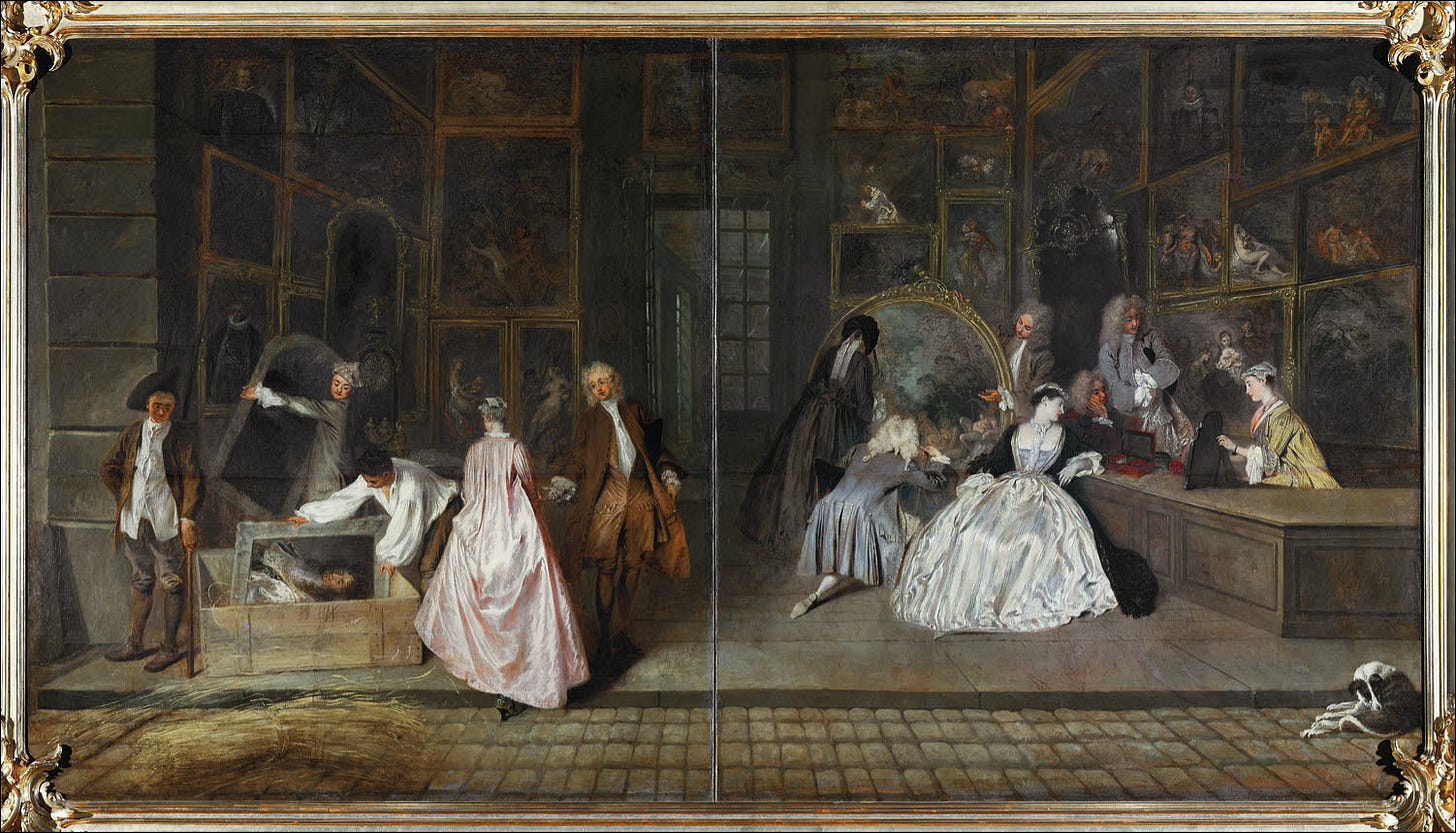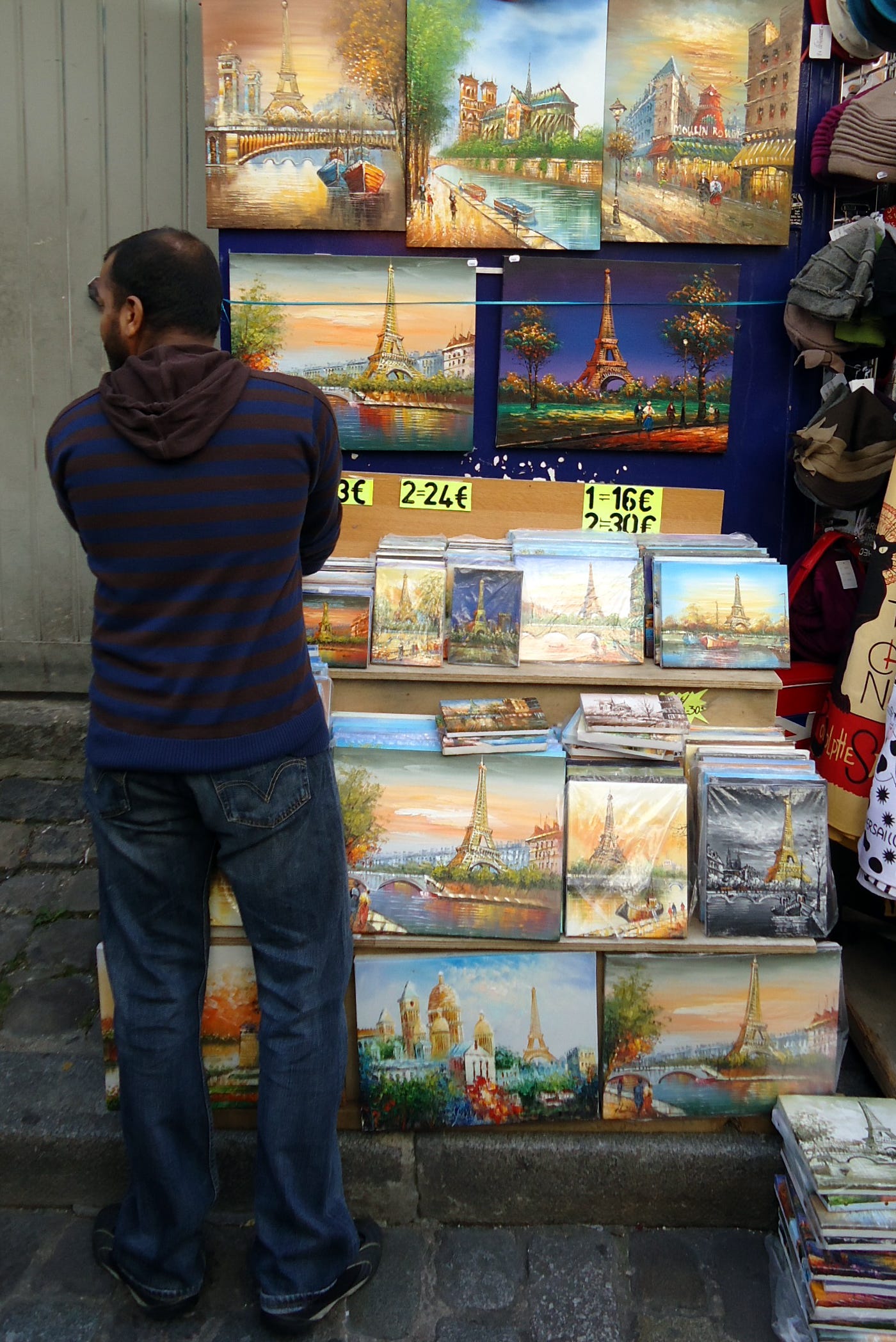A funny thing about art is that you are not supposed to discuss art and money at the same time. They are two subjects that are very uncomfortable with one another. If we are to believe that artmaking is a vocation rather than a career (see my previous post, “The Winner Is...”), then we must also believe that artists pursue their practice without a thought at all to profit. It is this (mis) belief that causes such a muddle when art and money are discussed together.
Of course, artists need money. To make art requires materials, a space to work, and the resources to spend the time required – meaning not having to sell their labour to someone else to earn a living. Few artists have this privilege. Money is also integral to how art is circulated in the world. Artworks are transformed into valuable commodities as they enter the market whether by street-level sellers or prestigious New York art gallerists. Selling art is a necessity and a curse for every artist.
Over the centuries, artists have resolved the dilemma of balancing the sacred act of making art and the profane act of selling art by enlisting intermediaries. Today we know these intermediaries as commercial art galleries. Commercial galleries, at least the kind that sell art by living artists, are a fairly recent phenomenon. Prior to the European Baroque period, artists only produced a painting or a sculpture when commissioned by a patron. Materials were too expensive to expend on speculative works. All of this changed with the evolution of world trade (yes, slavery, sugar, wool, etc.) that fueled the growth of European cities and industry. A new wealthy merchant class, especially in the Netherlands, began purchasing paintings to decorate their homes and businesses. Paintings of landscapes, seascapes, portraits, still life, religious images, and scenes of everyday life were popular subjects produced by artists like Rembrandt, Jan Vermeer, and Franz Hals. Seeing an opportunity, artists began to produce works on spec and sold these directly from their studios or at art academy salon exhibitions. By the early nineteenth century, with the advent of the artistic avant-garde, a new breed of entrepreneurial gallerists emerged. In Paris, for example, Paul Durand-Ruel marketed the work of the Impressionists and Daniel-Henri Kahnweiler promoted and sold the work of Picasso and the Cubists. Because of the radical nature of avant-garde art, these gallerists came to define themselves not only as the sellers of art but also as the interpreters and advocates of a type of art that few people understood.1

Today, there is a wide variety of ways in which art is marketed to the public: art fairs, auctions, and most notably, large and small commercial art galleries. These businesses manage the trade of art in almost every urban centre.
In his book, Talking Prices: Symbolic Meaning of Prices on the Market for Contemporary Art, Olav Velthuis makes some insightful observations on how commercial galleries, especially those that market the work of top contemporary artists, navigate the difficult terrain of the sacred and the profane.2 From 1998 through to 2001, Velthuis studied 37 contemporary art galleries in Amsterdam and New York.3 As part of this study, Velthuis identified and compared two types of commercial art galleries – what he calls avant-garde galleries and traditional galleries. The comparison is revealing.4
Avant-garde galleries specialize in new work by living contemporary artists. There is a wide range of these types of galleries catering to artists of different contemporary art genres and at different stages of their careers. The most renown of these businesses – the galleries that represent the most significant contemporary artists – are located in cities like Paris, New York, Berlin and London and include well-known dealers such as David Zwirner (New York), Hauser & Wirth (Zurich), Galerie Thaddaeus Ropac (Paris), and Lisson Gallery (London). As Velthuis notes, these galleries tend to deal only in the primary market (selling works directly from the artist) rather than the secondary market (re-selling works that were previously bought by collectors). Traditional galleries, on the other hand, sell a more eclectic mix of art genres, secondary works, and sometimes artist’s prints.
The two types of galleries differ not only in what they sell but also in their architectural presentation and sales approach. Velthuis found that avant-garde galleries in both Amsterdam and New York typically locate their operations outside of the city’s retail centres and away from primary shopping streets. They rent or buy buildings in out-of-the way districts. These areas offer large spaces at cheaper prices, but they are also located in industrial districts or mixed-use neighbourhoods where they are sometimes more difficult to find. The exteriors of avant-garde galleries are also very discrete. They avoid large signage or window displays that easily mark them as a gallery or commercial business. In contrast to the “covert location”5 of the avant-garde gallery, traditional galleries tend to be located in high-end retail areas near designer stores. Their exteriors are clearly marked with large signage and extensive window displays.
The interior of both types of galleries is usually divided into a “front room” and a “back room.” In the avant-garde gallery the front room is spare in its furnishings, décor, and display of product. There may be a single desk or reception area and no other furnishings. On entering the gallery, staff rarely engage with the visitor other than to politely acknowledge their presence. The interior walls are often white and the floors concrete or wood. The product – that is the artwork – is carefully hung or placed in the space with no sense of clutter. Typically, the work of only one artist is on display at a time and there are usually no visible price tags. If prices are available they will most likely be found on a printed list kept at the reception desk. The back room, which is usually out-of-sight and closed to the public, is much more active. Here artworks are stored and prepared for exhibition and sales. Sometimes, the gallery maintains a private viewing space or office where sales can be negotiated. With its front room designed as an exhibition space and its back room as a preparation space, the avant-garde gallery is clearly modelled on the modern art museum rather than a retail store.
Inside the traditional gallery, the space is again divided into front and back but this time the front of house is clearly an active sales area. There is far more art on the walls by many different artists. The interior space may also be filled with stands and pedestals featuring an array of sculptural work. Price tags will be on all of the work. The reception is more clearly marked as a sales desk and may even have a visible cash register. Staff is more engaging, greeting customers and telling them about the artists and the originality of specific works.
The sale of artwork also differ in these two types of galleries. In a traditional gallery sales are conducted openly in the front room. Anyone can enter these businesses and express an interest in a work and, if they can pay the price, they can make a purchase. Once a purchase is made, the artwork is taken from its place on the wall or pedestal, wrapped for transport, and the financial transaction is conducted at the sales desk. As Velthuis found in his interviews with gallery owners, the traditional gallerists take pride in how they provide an inviting atmosphere and do not cater to an exclusive clientele.6
Sales in the avant-garde gallery, on the other hand, are invisible and cloaked in art-world ritual. As Velthuis observes, “dealers within the avant-garde circuit, by contrast, seek to suppress the commodity character of contemporary art.”7 The sales activity, even if it does not look like such, begins when a new exhibition is hung and is ready to be shown. The artist’s new work is unveiled on a specific day (usually an evening) at an opening event or vernissage. A few weeks before the event, invitations are sent to the gallery’s and the artist’s contacts. On the evening or day of the vernissage, the invitees arrive dressed for a special event. They gather in the front room of the gallery where they mingle, view the work, meet the artist, and enjoy drinks and hors d'oeuvres. There may be a few short speeches but the emphasis is on the artworks, the artist, and the social event. There are no visible exchanges of money. The dealer, however, works the room and if a prospective buyer expresses interest in a piece, agreements will be made discretely and the sale finalized in the days after the vernissage. Once the sale is finalized, the artwork remains on the wall of the gallery until the end of the exhibition. Only a small red dot on the wall near the work indicates that the work has been sold.
Commercial art galleries, as Velthuis’ research indicates, provide artists with a solution to managing the troubling relationship between artmaking and money. But, Velthuis’ research also reveals how the two types of galleries – avant-garde and traditional – represent an obvious class (and artistic) divide between contemporary art and its other – the art that is not recognized as “contemporary art.” The traditional gallery also sells original art by living artists, but this art does not meet the artistic or conceptual expectations of the contemporary art world. These commercial gallery then provide artists who are left out of the contemporary genre with a retail space where they can still maintain a distance from the financial transaction that comes with selling their art. The avant-garde gallery, on the other hand, provides contemporary artists with much more; a space that highlights the artworks and the artist’s individual singularity while at the same time maintaining the illusion that art and money never meet even if the two are the necessary partners in the production of contemporary art.
For a good, readable history of marketing modern art see Peter Watson, From Manet to Manhattan: The Rise of the Modern Art Market (New York: Random House, 1992).
Olav Velthuis, Talking Prices: Symbolic Meaning of Prices on the Market for Contemporary Art (Princeton: Princeton University Press, 2005).
Velthuis, Talking Prices, 19.
See Velthuis, Chapter One, “The Architecture of the Art Market,” 21-52.
Velthuis, Talking Prices, 45.
Velthuis, Talking Prices, 46.
Velthuis, Talking Prices, 52.





Dear Marie;
Excellent research for a relationship seldom addressed. This is a valuable note that is helpful for me at this very moment. I will explain this comment by phone later in the coming week.